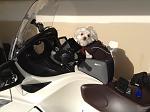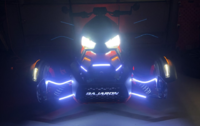|
-
 Can technology solve the hydroplaning issue with Spyders? Can technology solve the hydroplaning issue with Spyders?
I'm no expert. And, I have my own 'common sense' biases about what the trade-offs might be between wet road traction and dry road traction in tires. But, I'd rather hear from the folks with true expertise in tire technology as well as those who have real-world experiences of hydroplaning on their Spyder.
My bias is that the flat profile of the Spyder tires creates great traction on dry road, but contributes to hydroplaning on roads with standing water. I think there are probably tires (car tires) that have a reputation for good traction in both dry and wet conditions, but not necessarily hydroplaning conditions (an inch or more of standing water on the road). A tire that does have excellent wet-road performance to combat hydroplaning probably has either very poor life, or poor dry-road handling or some other unacceptable trade-off.
Maybe, as most have said on this forum, the only solution in hydroplaning situations is to slow down and get off the road until those conditions have passed.
All of this above is 'seat of the pants' and I'm sure there are plenty others with supportive or contradictory opinions. But, what I'm hoping to hear is opinions based on technological expertise and / or real-world experiences.
Thanks.
2014 RTL Platinum

-
Very Active Member

 HYDROPLANING QUESTION HYDROPLANING QUESTION
 Originally Posted by UtahPete

I'm no expert. And, I have my own 'common sense' biases about what the trade-offs might be between wet road traction and dry road traction in tires. But, I'd rather hear from the folks with true expertise in tire technology as well as those who have real-world experiences of hydroplaning on their Spyder.
My bias is that the flat profile of the Spyder tires creates great traction on dry road, but contributes to hydroplaning on roads with standing water. I think there are probably tires (car tires) that have a reputation for good traction in both dry and wet conditions, but not necessarily hydroplaning conditions (an inch or more of standing water on the road). A tire that does have excellent wet-road performance to combat hydroplaning probably has either very poor life, or poor dry-road handling or some other unacceptable trade-off.
Maybe, as most have said on this forum, the only solution in hydroplaning situations is to slow down and get off the road until those conditions have passed.
All of this above is 'seat of the pants' and I'm sure there are plenty others with supportive or contradictory opinions. But, what I'm hoping to hear is opinions based on technological expertise and / or real-world experiences.
Thanks.
" NO "using the Brain in conjunction with the right hand / wrist .... I wouldn't call that " Technology " ..... but it works .................Mike 
-

No not to any meaningful extent because.........
Once you exceed a certain critical speed and the tire completely loses contact with the pavement, you are just sailing free and the only thing that will stop it is scrubbing off some speed or the water going away.
Nothing will scrub off speed.......unless some of the tires still have traction. In that case, ABS and traction control (the nanny) can help.
If ALL of the tires are floating, nothing will help. They can all be locked up and it won't slow down much. Which incidentally is not a good thing to do because having all wheels locked makes for a very abrupt transition when the "puddle" ends. 
The recommended course of action is basically the same as if you are skidding on glare ice.
-

 Originally Posted by Easy Rider

No not to any meaningful extent because....Once you exceed a certain critical speed and the tire completely loses contact with the pavement, you are just sailing free and the only thing that will stop it is scrubbing off some speed or the water going away.
I remember some time back, various car tire manufacturers (Goodyear was one I think) were promoting their Aqua-Tred or some such model as being superior in heavy rain conditions because the tread pattern was such that it dispersed the water and reduced hydroplaning. That's the kind of thing I'm talking about when I refer to 'technology'.
I'm wondering if some of the car tires that we fit to our Spyders have that technology and whether anyone has any experience with or expert opinions about them.
In the most extreme form of tread pattern, the tread is in sharply defined parallel pattern in the direction of rotation; doesn't this have the same effect as a narrow tire would?
This is what TireRack.com has to say about it;
Hydroplaning: the Role Tires Play
(Lea en espaņol)
Hydroplaning happens when one or more tires is lifted from the road by a wedge of water that gets trapped in front of and under a tire as the vehicle drives through water. Hydroplaning most frequently occurs during heavy rainstorms when water creates puddles on the highway or expressway. In addition to the accompanying splash and scaring the heck out of the driver, hydroplaning typically causes the steering wheel to jerk and the vehicle to abruptly pull towards the puddle.
The speed at which a tire hydroplanes is a function of water depth, vehicle speed, vehicle weight, tire width, tread depth and tread design. It depends on how much water has to be removed, how much weight is pressing down on the tires and how efficient the tread design is at evacuating water. While deeper water, higher speeds, lighter vehicles, wider tires, less tread depth and less efficient tread designs will cause tires to hydroplane at lower speeds; all tires will be forced to hydroplane at some speed.
As a rule, tread design affects hydroplaning resistance at high speeds and in deep water. Tread compound affects wet traction at lower speeds or in shallow water.
Directional tread designs (sometimes called Unidirectional tread designs) are frequently used on tires intended to better resist hydroplaning. Their multiple tread grooves are aligned in a repeating "V" shape to increase the tire's ability to channel water from between the tire's footprint and the road. Somewhat like the vanes of a water pump continually pushing water in one direction through the engine, the grooves of a directional tire are designed to push water in one direction through the tire (forward on an angle to the sides). Directional tread designs are especially helpful in increasing hydroplaning resistance when relatively wide Plus Two, Plus Three or Plus Four tire and wheel applications result in fitting a much wider tire to a vehicle than its Original Equipment size.
Last edited by UtahPete; 06-10-2018 at 02:31 PM.
2014 RTL Platinum

-

The Firestone blog has this to say about hydroplaning;
S – Slow down. You don’t have to be driving especially fast to create the ideal conditions for hydroplaning. Any speed above 35 miles per hour could put you at risk. And it doesn’t necessarily have to be raining — “wet” can mean roads that are merely damp.
A – Allow more distance between cars. In normal driving conditions, it’s best to leave a three- or four-second gap between you and the car immediately in front of you. In rainy and wet conditions, extend that length of time to give yourself more room to stop, just in case the road starts to feel like a slip ‘n slide.
F – Follow in the tracks of the vehicle in front of you. One of the reasons even damp roads can create dangerous conditions for drivers is because just a little water is enough to bring oil and other residues to the road’s surface. That makes it more difficult for your tires to maintain safe traction with the road. Following in the tracks of the vehicle in front of you means some of that slippery cocktail is being wicked away before your tires get there, leaving you with a drier (and safer) path.
E – Examine your tires. In addition to your braking system, your tires are one of your car’s most important safety features. Properly inflated and rotated tires with good tread depth will perform much better on wet roads than under/over-inflated or worn tires. Worn tires, even ones that aren’t “worn out,” can be deadly on wet roads, says Consumer Reports, because the grooves aren’t deep enough to channel water out from beneath the tread. The result? Hydroplaning.
2014 RTL Platinum

-
Very Active Member


It has been mentioned now at least three times. If you have to drive through standing water, slowing down (below 55) will improve your chances to survive a hydroplaning incident. The "nanny" also helps. It is true. It has happened to me twice (mentioned earlier), and slowing down does work.
The manual also addresses the situation. No cure--just slow down and be alert to the situation.
  
  Currently Owned: 2019 F3 Limited, 2020 F3 Limited: SOLD BOTH LIMITEDS in October of 2023.
Currently Owned: 2019 F3 Limited, 2020 F3 Limited: SOLD BOTH LIMITEDS in October of 2023.
Previously : 2008 GS-SM5 (silver), 2009 RS-SE5 (red), 2010 RT-S Premier Editon #474 (black) 2011 RT A&C SE5 (magnesium) 2014 RTS-SE6 (yellow)
MY FINAL TALLY: 7 Spyders, 15 years, 205,500 miles
IT HAS BEEN A LONG, WONDERFUL, AND FUN RIDE.

-
 Discount Tire Direct says this about hydroplaning Discount Tire Direct says this about hydroplaning
Hydroplaning occurs when the tires encounter more water than they can physically displace. This causes one or more tires to lose contact with the driving surface, resulting in the temporary loss of steering, acceleration, and braking control. This typically happens during and after heavy rain, when water has created pools and puddles on the road surfaces.
As your tires wear out, their ability to evacuate water from the contact patch is reduced. Tires with low to worn-out tread are more likely to lose traction and hydroplane in wet conditions than tires with more tread.
Manufacturers make tires that are specifically designed for wet-weather conditions and increased hydroplaning resistance. Directional, asymmetric, and tread patterns featuring deep circumferential grooves typically provide better hydroplaning resistance.
The main factors that can affect tire hydroplaning can include:
- water depth
- vehicle speed
- vehicle weight
- tire width
- tread depth
- tread design
A lighter vehicle with narrow tires and low tread depth will hydroplane at a much lower speed than a heavier vehicle with wide tires and deep tread. In the wrong conditions, hydroplaning can happen to any vehicle. The best way to avoid hydroplaning is to drive with caution and to make sure your tires have enough tread depth to evacuate water on the road surfaces.
TIPS TO HELP PREVENT HYDROPLANING
- Ensure that your tires are properly inflated
- Maintain your tires regularly, particularly checking the tread depth
- Drive cautiously, reducing speeds if needed, on wet surfaces and in rainy conditions
- Try to avoid puddles and areas that tend to collect standing water
- Avoid hard breaking or sudden stopping
- In wet conditions, approach curves and turns with extreme caution, and maintain a slower speed than you would normally use in dry conditions
2014 RTL Platinum

-
Very Active Member


 Originally Posted by UtahPete

I'm no expert. And, I have my own 'common sense' biases about what the trade-offs might be between wet road traction and dry road traction in tires. But, I'd rather hear from the folks with true expertise in tire technology as well as those who have real-world experiences of hydroplaning on their Spyder.
My bias is that the flat profile of the Spyder tires creates great traction on dry road, but contributes to hydroplaning on roads with standing water. I think there are probably tires (car tires) that have a reputation for good traction in both dry and wet conditions, but not necessarily hydroplaning conditions (an inch or more of standing water on the road). A tire that does have excellent wet-road performance to combat hydroplaning probably has either very poor life, or poor dry-road handling or some other unacceptable trade-off.
Maybe, as most have said on this forum, the only solution in hydroplaning situations is to slow down and get off the road until those conditions have passed.
All of this above is 'seat of the pants' and I'm sure there are plenty others with supportive or contradictory opinions. But, what I'm hoping to hear is opinions based on technological expertise and / or real-world experiences.
Thanks.
Last year we had a group of 9 Spyders with different tires. Some stock, but most car tires. Hit some terrible rain in route to event. All of them hydro plane except 1 spyder. My wifes didn't at all. Now she had stock tires on front and a Yokohama S drive on back. I now have a S drive on the back of mine and real happy with it. She was riding a 2011 RSS SE5 and was the less experience rider. I was worried during trip. Mine hydro planed several times and fished tailed several times. Haven't been in a lot of rain since putting the rear tire on, but I feel it will handle well. Of course you get in the right condition all will hydro plane.
David
-

The way I see it, the Spyder is handicapped from the beginning with it's design. Being a three wheeler, at any time, one of its three tires will be tracking in a wet or dirty part of the lane. If you try to follow in other car tire's tracks where there is less water, one or more of the other tires will not be in the "dryish" lane. This creates an unbalanced grip situation.
Many two wheeled motorcycles now have a "rain" mode on their traction control. In fact as far back as 2008 one of my sport bikes has had a "track", "street" and "rain" setting. Rain mode was a fuel mapping that offered less aggressive power hit and limited peak power.
The Spyder being so electronic could offer such a mode to mitigate hydroplaning, same with tire design. But nothing technological will absolutely prevent hydroplaning other than the nut behind the handlebar knowing better and slowing down or pulling over.
When life throws you curves, aim for the apex
Current stable: 09 Thruxton / 09 FZ6
Sold List: 97 Ninja500R, 03 SV650K3, 01 Ducati 750Sport Dark, 73 CB350/4, 03 F650GSA, 08 Gixxer600, 03 Gixxer600, 91 VFR750F, 09 KLX250, 06 Thruxton 900, 08 Spyder RS , 12 Street TripleR, 15 RC390, 02 VFR800, 09 KLX250S, 10 F650GS
JLohPhotos
... Motorcycles are kind of like Baskin Robbins... You're looking at 31 flavors of ice cream, don't you kind of want to know what they all taste like?...

-
Ozzie Ozzie Ozzie


I dunno which thread this should belong in, cos it seems we have a few on this subject (again) so while I posted this elsewhere, FWIW I'll post it here too. Sorry to all those who've waded thru it already, but I'm putting it out there for others/everyone to take & do with as they will.... 
Funnily enough, dropping your tire pressures a little below that you usually run on dry roads often DOES help reduce hydroplaning, because it doesn't usually make the contact patch much WIDER, it generally makes that contact patch proportionally LONGER - and in doing so allows the sipes & grooves in the tread to move a little as they flex onto the road surface,, gripping the road like little fingers, as well as effectively PUMPING the water away from the contact patch, and in doing this it also lessens the wedge of water created in front of the tire that is what lifts the contact patch & creates the hydroplaning problem in the first place!! 
But it is a fairly fine line, tire pressure that's too high makes the tire unable to flex so it can't act as a pump or reach optimum tread &/or compound operating temps, so it's like running on a railway wheel.... fine while you are going slow enough, but they'll always give an awful rough ride, and once you get going faster, it gives you all the drawbacks of an ice skate on polished concrete & none of the benefits!! Plus it only lets the large tread pattern grooves move water away from the contact patch - none or very little gets moved by the smaller sipes; the tread compound itself is too cold & hard to do any 'gripping'; the sipes don't open as the tread flexes onto the contact patch so it doesn't do any of the 'pumping action' that the tread is designed to create; and the compound itself is either too cold & hard to grab (cos the tire hasn't flexed enough to warm up) or it's too hot & runny & floppy as it approaches delamination temps!! 
Then there's the little window which is the optimum pressure for the load that Mike & I spend so much time talking about, where both the tread pattern and the tread compound get to work as they were designed under the load placed upon them - and btw, once you are running aftermarket tires, those optimum pressures generally have little to do with the vehicle manufacturers 'recommended pressures' for the OE Spec tires, simply because the pressures are mainly TIRE & LOAD dependant, varied somewhat by riding style & ambient temps etc, but definitely not aimed at selling more vehicles or OE Spec tires. Regardless, at optimum pressures, the tread grooves start moving water away from the contact patch as the tire rolls onto the road; the smaller channels & sipes open as the tread flexes down onto the road & then start to close again as they pass thru the contact patch, initially collecting & grabbing water & then forcing it out to the sides of the tire as they close, acting like little pumps to move more water away from the contact patch; and at the same time they are acting as sticky fingers grabbing onto the road surface & hanging on because they are hot & sticky without being too hot to be virtually useless &/or runny/delaminating!! 
And then you can get pressures that are too low, generally down so low that the tire might have difficulties staying on the rim. This is where lowering the pressure starts making the contact patch wider more than it makes it longer, and it is pretty low for most aftermarket tires carrying the fairly light load imposed by our Spyders.... think about even lower than about 8psi, down in that vicinity; if you want, you can do the 'ink test' on how changing pressures impact on the contact patch under load (use a small puddle of water on an otherwise dry road instead of ink & paper tho, it's easier to source, do, and clean up!  ) you'll see very quickly when the contact patch width starts to increase proportionally MORE than its length increases as the pressures drop & you lower the tire under its load onto a dry surface.... you really don't want your tire pressures to be down there, cos the tire CAN roll off the rim, the centre of the tread/contact patch starts to bow up & in, lifting off the road surface & allowing even more water to collect in there, the outside edge of the tread becomes the only bits left touching the road surface, massively reducing the contact patch area & minimising grip & the ability of the tread to move water out of the way, and basically becoming almost as dangerous as running pressures that are too high!! ) you'll see very quickly when the contact patch width starts to increase proportionally MORE than its length increases as the pressures drop & you lower the tire under its load onto a dry surface.... you really don't want your tire pressures to be down there, cos the tire CAN roll off the rim, the centre of the tread/contact patch starts to bow up & in, lifting off the road surface & allowing even more water to collect in there, the outside edge of the tread becomes the only bits left touching the road surface, massively reducing the contact patch area & minimising grip & the ability of the tread to move water out of the way, and basically becoming almost as dangerous as running pressures that are too high!! 
So in a nutshell, tire pressures that are too high are dangerous; tire pressures that are too low are dangerous; & the 'just right' tire pressures that Mike & I bang on so much about are as safe as you'll get, JUST SO LONG AS YOU DROP YOUR SPEED to be SLOW ENOUGH BEFORE YOU HIT THE WATER!! 
Someone said it earlier, ! I'll paraphrase it here - the best preventative action against hydroplaning you can take is less twist in that right wrist.... 
Enjoy! 
2013 RT Ltd Pearl White
Ryde More, Worry Less!
-
Very Active Member

 WELLLLLLL NOW THAT YOU MENTION IT WELLLLLLL NOW THAT YOU MENTION IT
 Originally Posted by Peter Aawen

I dunno which thread this should belong in, cos it seems we have a few on this subject (again) so while I posted this elsewhere, FWIW I'll post it here too. Sorry to all those who've waded thru it already, but I'm putting it out there for others/everyone to take & do with as they will.... 
Funnily enough, dropping your tire pressures a little below that you usually run on dry roads often DOES help reduce hydroplaning, because it doesn't usually make the contact patch much WIDER, it generally makes that contact patch proportionally LONGER - and in doing so allows the sipes & grooves in the tread to move a little as they flex onto the road surface,, gripping the road like little fingers, as well as effectively PUMPING the water away from the contact patch, and in doing this it also lessens the wedge of water created in front of the tire that is what lifts the contact patch & creates the hydroplaning problem in the first place!! 
But it is a fairly fine line, tire pressure that's too high makes the tire unable to flex so it can't act as a pump or reach optimum tread &/or compound operating temps, so it's like running on a railway wheel.... fine while you are going slow enough, but they'll always give an awful rough ride, and once you get going faster, it gives you all the drawbacks of an ice skate on polished concrete & none of the benefits!! Plus it only lets the large tread pattern grooves move water away from the contact patch - none or very little gets moved by the smaller sipes; the tread compound itself is too cold & hard to do any 'gripping'; the sipes don't open as the tread flexes onto the contact patch so it doesn't do any of the 'pumping action' that the tread is designed to create; and the compound itself is either too cold & hard to grab (cos the tire hasn't flexed enough to warm up) or it's too hot & runny & floppy as it approaches delamination temps!! 
Then there's the little window which is the optimum pressure for the load that Mike & I spend so much time talking about, where both the tread pattern and the tread compound get to work as they were designed under the load placed upon them - and btw, once you are running aftermarket tires, those optimum pressures generally have little to do with the vehicle manufacturers 'recommended pressures' for the OE Spec tires, simply because the pressures are mainly TIRE & LOAD dependant, varied somewhat by riding style & ambient temps etc, but definitely not aimed at selling more vehicles or OE Spec tires. Regardless, at optimum pressures, the tread grooves start moving water away from the contact patch as the tire rolls onto the road; the smaller channels & sipes open as the tread flexes down onto the road & then start to close again as they pass thru the contact patch, initially collecting & grabbing water & then forcing it out to the sides of the tire as they close, acting like little pumps to move more water away from the contact patch; and at the same time they are acting as sticky fingers grabbing onto the road surface & hanging on because they are hot & sticky without being too hot to be virtually useless &/or runny/delaminating!! 
And then you can get pressures that are too low, generally down so low that the tire might have difficulties staying on the rim. This is where lowering the pressure starts making the contact patch wider more than it makes it longer, and it is pretty low for most aftermarket tires carrying the fairly light load imposed by our Spyders.... think about even lower than about 8psi, down in that vicinity; if you want, you can do the 'ink test' on how changing pressures impact on the contact patch under load (use a small puddle of water on an otherwise dry road instead of ink & paper tho, it's easier to source, do, and clean up!  ) you'll see very quickly when the contact patch width starts to increase proportionally MORE than its length increases as the pressures drop & you lower the tire under its load onto a dry surface.... you really don't want your tire pressures to be down there, cos the tire CAN roll off the rim, the centre of the tread/contact patch starts to bow up & in, lifting off the road surface & allowing even more water to collect in there, the outside edge of the tread becomes the only bits left touching the road surface, massively reducing the contact patch area & minimising grip & the ability of the tread to move water out of the way, and basically becoming almost as dangerous as running pressures that are too high!! 
So in a nutshell, tire pressures that are too high are dangerous; tire pressures that are too low are dangerous; & the 'just right' tire pressures that Mike & I bang on so much about are as safe as you'll get, JUST SO LONG AS YOU DROP YOUR SPEED to be SLOW ENOUGH BEFORE YOU HIT THE WATER!! 
Someone said it earlier, ! I'll paraphrase it here - the best preventative action against hydroplaning you can take is less twist in that right wrist.... 
Enjoy! 
Peter ...    ...... You love to type or you are just good at it.............. You know the tire pressure thing ...and I know the tire pressure thing , but I don't think folks are reading this .....Why because tomorrow or the Day after someone will say " Well why or prove you right " ...... You love to type or you are just good at it.............. You know the tire pressure thing ...and I know the tire pressure thing , but I don't think folks are reading this .....Why because tomorrow or the Day after someone will say " Well why or prove you right "     ......... But please keep up the good fight ...... At least no one is posting about why over-pressured tires are better and or Safer ......... But please keep up the good fight ...... At least no one is posting about why over-pressured tires are better and or Safer      ..........Mike ..........Mike 
-

 Originally Posted by BLUEKNIGHT911

Mike, we are listening (reading, actually), but your posts are full of emojis and emotion, which can obscure the very valid point you are trying to make. That's all. Nothing disrespectful intended.
2014 RTL Platinum

-
Very Active Member

 EMOJIS EMOJIS
 Originally Posted by UtahPete

Mike, we are listening (reading, actually), but your posts are full of emojis and emotion, which can obscure the very valid point you are trying to make. That's all. Nothing disrespectful intended.
Pete this emojis thing is apparently at Critical Mass for you ...... immediately contact the Administrator and DEMAND they remove the ability to use emojis. !!!!!.... Mike 
-
SpyderLovers Sponsor

 Technology... Maybe Technology... Maybe
But really, the only cure to hydroplaning is an effective reduction in speed.
Take water skiing for example. I used to watch my dad water ski (which he loved). And when I grew up I tried it myself. You start a beginner on big skis at slow speeds. As you get better you can go faster and you can do it with smaller, more maneuverable skis without sinking. At higher speeds, my dad would kick off his skis and go with just his feet.
Point being. At a certain speed with a certain amount of surface area (your tire in this case) applied to a sufficient depth of water, no amount of technology is able to overcome the effects of the physical laws involved. You are going to hydroplane.
Now having a tire specifically designed to efficiently shed water, and a rubber compound specifically designed to increase traction in wet conditions, will reduce the tendency to hydroplane. But only to a point.
As mentioned many times already. Slowing down is the only 'technology' available to prevent hydroplaning.
Last edited by BajaRon; 06-11-2018 at 08:46 AM.
Shop Ph: 423-609-7588 (M-F, 8-5, Eastern Time)
Only SLOW people have to leave on time...


-

 Originally Posted by BajaRon

But really, the only cure to hydroplaning is an effective reduction in speed.
Take water skiing for example. I used to watch my dad water ski (which he loved). And when I grew up I tried it myself. You start a beginner on big skis at slow speeds. As you get better you can go faster and you can do it with smaller, more maneuverable skis without sinking. At higher speeds, my dad would kick off his skis and go with just his feet.
Point being. At a certain speed with a certain amount of surface area (your tire in this case) applied to a sufficient depth of water, no amount of technology is able to overcome the effects of the physical laws involved. You are going to hydroplane.
Now having a tire specifically designed to efficiently shed water, and a rubber compound specifically designed to increase traction in wet conditions, will reduce the tendency to hydroplane. But only to a point.
As mentioned many times already. Slowing down is the only 'technology' available to prevent hydroplaning.
Great analogy. Thanks!
2014 RTL Platinum

-

 Originally Posted by UtahPete

I remember some time back, various car tire manufacturers (Goodyear was one I think) were promoting their Aqua-Tred or some such model as being superior in heavy rain conditions because the tread pattern was such that it dispersed the water and reduced hydroplaning. That's the kind of thing I'm talking about when I refer to 'technology'.
You confused me. I would call that "tire design", not "technology".
But yes, of course tread design plays a big part.
Poor wet performance will "float" sooner and last longer......speed wise.
-

 Originally Posted by Easy Rider

You confused me. I would call that "tire design", not "technology".
But yes, of course tread design plays a big part. Poor wet performance will "float" sooner and last longer......speed wise.
So, that might be one of the considerations in selecting a tire - wet road performance. I don't see that being much consideration when we talk about tires. I know Mike has mentioned it occasionally, but the information on that aspect of tire performance seems to be generally not mentioned. Most of the focus has been on dry cornering and longevity.
Any idea where to get the wet performance info on the various tires promoted for Spyder use on this forum? Is it on the sidewall or something?
2014 RTL Platinum

-
2014 RTL Platinum

-

 Originally Posted by UtahPete

Any idea where to get the wet performance info on the various tires promoted for Spyder use on this forum? Is it on the sidewall or something?
Have a look here:
https://www.nhtsa.gov/equipment/tires
One of the ratings on the sidewall is "traction" which is supposed to be "wet traction" but I don't know exactly what that means.
It might not have much to do with shedding water in a hydroplaning situation.
-
Very Active Member

 TIRE TESTING INFO - omg TIRE TESTING INFO - omg
 Originally Posted by Easy Rider

Have a look here:
https://www.nhtsa.gov/equipment/tires
One of the ratings on the sidewall is "traction" which is supposed to be "wet traction" but I don't know exactly what that means.
It might not have much to do with shedding water in a hydroplaning situation.
Just another USELESS report .....they are talking about " Cars & Trucks " .... what occurs is really unique to Spyders ....not even conventional Trikes can be compared to the Spyder ...... Mike 
-
Very Active Member

 AND THE SOLUTION IS AND THE SOLUTION IS
-

 Originally Posted by BLUEKNIGHT911

Just another USELESS report .....they are talking about " Cars & Trucks " .... what occurs is really unique to Spyders ....not even conventional Trikes can be compared to the Spyder ...... Mike 
Unless if you're one of those ryders using CAR tires. Then there might be some relevance, don't you think? After all, the tire doesn't know or care what kind of vehicle it's mounted on.
If I had a very light vehicle, say a Lotus 7, or Polaris Slingshot, running "rain" tires vs "slicks" would make a difference in the wet. I would guess a Spyder, other than the 3 wheels, might behave similarly with the same tire choice.
Last edited by asp125; 06-11-2018 at 07:02 PM.
When life throws you curves, aim for the apex
Current stable: 09 Thruxton / 09 FZ6
Sold List: 97 Ninja500R, 03 SV650K3, 01 Ducati 750Sport Dark, 73 CB350/4, 03 F650GSA, 08 Gixxer600, 03 Gixxer600, 91 VFR750F, 09 KLX250, 06 Thruxton 900, 08 Spyder RS , 12 Street TripleR, 15 RC390, 02 VFR800, 09 KLX250S, 10 F650GS
JLohPhotos
... Motorcycles are kind of like Baskin Robbins... You're looking at 31 flavors of ice cream, don't you kind of want to know what they all taste like?...

-

 Originally Posted by Easy Rider

Have a look here:
https://www.nhtsa.gov/equipment/tires
One of the ratings on the sidewall is "traction" which is supposed to be "wet traction" but I don't know exactly what that means.
It might not have much to do with shedding water in a hydroplaning situation.
That's a good starting point, I think;
Traction grades are an indication of a tire's ability to stop on wet pavement. A higher graded tire should allow a car to stop on wet roads in a shorter distance than a tire with a lower grade. Traction is graded from highest to lowest as "AA", "A", "B", and "C".
Of current tires:
- 15% are rated "AA"
- 77% are rated "A"
- 7% are rated "B"
- Only 4 lines of tires are rated "C"
2014 RTL Platinum

-

 Originally Posted by BLUEKNIGHT911

Just another USELESS report .....they are talking about " Cars & Trucks " .... what occurs is really unique to Spyders ....not even conventional Trikes can be compared to the Spyder ...... Mike 
Then what do YOU suggest we do in trying to determine the relative wet traction ability of the different tires we are looking at for our Spyders?
2014 RTL Platinum

-

I'd have to put you on the ignore list, and I'm not going to do that. Why are you so angry?
2014 RTL Platinum

 Posting Permissions
Posting Permissions
- You may not post new threads
- You may not post replies
- You may not post attachments
- You may not edit your posts
-
Forum Rules
|





 Reply With Quote
Reply With Quote

















